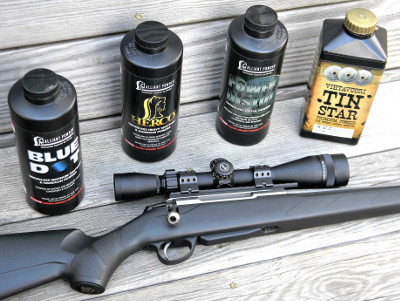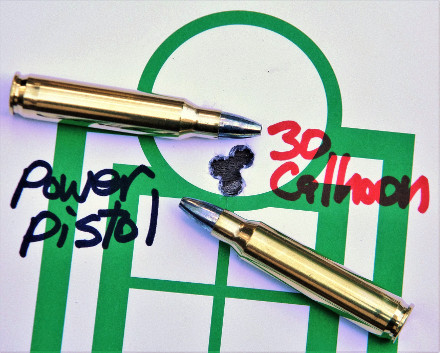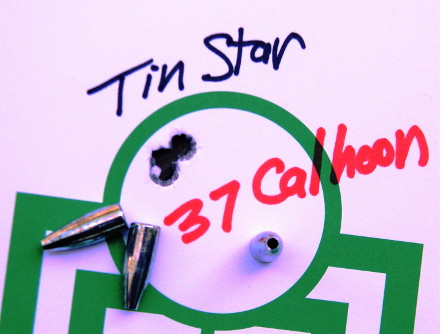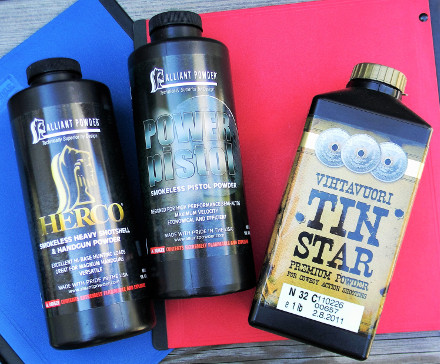
In
Part 1, I covered the successes of developing low barrel heat, low recoil loads for the .223, based on James Calhoon’s
Gopher Loads(www.jamescalhoon.com ) using moderate charges of Blue Dot, for prairie dogs, pests or practice. With only 13 to 15 grains of Alliant Blue Dot, his Double Hollow Point 30, 37 and 42 grain varmint bullets reach 3,600, 3,200 or 3,000 fps respectively… and regularly shot around a half-inch at 100 yards from my stainless Tikka T3 Lite sporter. Then I ran out of Blue Dot, could not locate any more, and wondered
“What now?”
Calhoon’s Double Hollow Points are highly explosive varmint bullets with thin brass jackets, and his exclusive Slick Silver™ electro-chemically bonded coating. The silver-colored, shiny metallic finish- which doesn’t come off on your hands- allows for shooting 100 ~ 150 rounds without cleaning. It acts as a slippery bore lubricant, reducing metal fouling and making cleaning much easier.The very thin brass he uses for his bullet jackets are more brittle than copper. And the bullets feature an additional hollow point within the lead core. The result is a bullet that “shatters” readily on impact, producing a rather spectacular on-target display.
Blue Dot worked so well for these loads because it was a very bulky flake powder which burned cleanly while producing useable “varmint” speeds with great accuracy. Because of its great bulk, when used in loads that resulted in 63 ~ 78% fill rates, double charging was not possible. A double charge would spill out all over your bench, alerting you to the error.
Scanning over burn rate charts, and running various powders through the QuickLOAD ballistic program’s incremental stepping function, some bulky, relatively faster burning powders emerged as possible candidates. From Alliant, I would be testing two flake powders- Herco and Power Pistol; and Vihtavuori’s Tin Star (N32C), which is an extruded powder specifically designed for high-bulk to produce lower speeds with nearly casefulls under lead bullets in cowboy handgun rounds.
So armed with these three powders, I sat down with QuickLOAD, and proceeded to run the numbers, again limiting top pressures to 45,000 PSI or less, while keeping the fill rate to 55% or above. My projectiles of choice would again be Calhoon’s Slick-Silver™ Double...
Hollow Points in 30, 37 and 42 grains. A Leupold MK-AR 6-18x40mm scope was used on my stainless Tikka T3 Lite (NOT the heavy-barreled varmint model) having a 22.4” barrel, measuring .625” at the muzzle. I used a Hornady O.A.L. modified case and tool to determine the loaded length of the three Calhoon bullets. The 37 and 42 grain bullets were seated to 2.215” and 2.240” respectively, to allow for 0.010” jump to the rifling. The much shorter and blunter nose of the 30 grain Double Hollow Point, meant for the .22 Hornet, were seated to only 2.100” to allow for adequate support in the neck.

Low Recoil, Low Barrel Heating Loads
Click to LOAD DATA SHEET
For well over 20 years, I’ve been creating MELs- or Moderate, Effective Loads- for all of my centerfire hunting rifles. Instead of a casefull of slow burning powders to achieve 3,000+ fps, I load 35 to 45 grains of medium to medium fast burning rifle powders- such as H4198, H4895 or H322- resulting in around 2,700 fps loads. They work great for practice or even hunting out to 200 yards or more, and are excellent for starting young or beginning shooters out with traditional hunting calibers, with loads that produce around half the recoil of full-power ammunition.
So the concept of not filling a case up all the way with traditional powders is very comfortable for me. Around fifteen years ago when I first tried Calhoon’s Gopher Loads, my first trip to the range, and I knew he had a winner! While Blue Dot works great in the .223, as we all know, powder availability is still a hit-or-miss proposition nowadays. So I wanted to be able to offer shooters more options for creating these useful loads.
All loads used once-fired Lake City military 5.56 brass and would also be safe in any .223 commercial brass. Both Remington and Winchester small rifle primers were used with no noticeable differences. Velocities were recorded using a Competitive Edge DynamicsCED M2...
chronograph.
So let’s see how my three alternate choices worked out…

Alliant HERCO-
Herco is a large diameter flake powder very similar looking to Blue Dot, but almost black in color. 11 and 12 grains were tested under the 30 grain Calhoon, filling the case to between 70 and 76%. The starting charge produced 3,169 fps and rewarded me with 0.55” 3-shot groups at 100 yards. The top charge of 12 grains upped the speed to over 3,330 and gave similar sized groups. It burned very clean and resulted in a mild report at the shot.
The 37 grain bullet was shot under 11.0 and 11.5 grains of Herco. Velocities were 2,928 and 3,014 fps, with the top charge producing 0.47” groups. Lastly, I tried the 42 grain Calhoon over 10 and 11 grains, delivering around 2,700 to 2,800 fps. Again, the top charge was slightly more accurate, with 3-shots groups of right around 3/8”. This is excellent performance for a load which duplicates the classic .22 Hornet.
Alliant POWER PISTOL-
Power Pistol is also a flake powder, but maybe half the diameter of Herco or Blue Dot, and light silver/gray in color. Due to its smaller size, it meters very well. With the 30 grain bullet, it produced 3,364, 3,468 or 3,611 fps, under 11.5, 12.0 or 13.0 grains. The first two loads averaged just under a half-inch; the top load shot into right around 5/8”.
I obtained groups of just over a half inch with the 37 grain bullet and 11 or 12 grains of Power Pistol. Speeds were 3,069 and 3,245 fps, respectively. The top load was more accurate, and with its higher speed, would work well out to 250 yards on pests. I obtained excellent groups with the heaviest 42 Calhoon, seeing 3/8ths inch groups result when loaded over 11 grains, for 2,931 fps. 12 grains gave me 120 fps more, with groups still under a half inch. All around, this last load is an excellent performer in the .223.
Vihtavuori TIN STAR (N32C)-
Ever go to pick up a gallon of milk which you think is full, only to have your arm shoot up, when you then realize it was almost empty? Tin Star gives me the...
same first impression. While the .223 case can hold 28 grains or more of a dense ball powder, a case full of Tin Star (NOT a recommended load!) only weighs around 12 grains! A very light weight extruded “log” powder, it was designed specifically to provide mild lead bullet loads for cowboy action shooters, while almost filling up the case to minimize airspace. In a .223, it worked well with the lightest bullet, and performed excellently with the two heavier ones.

With 9, 10 or 11 grains of Tin Star, the 30 grain Calhoon produced 2,563 to just over 2,800 fps, and averaged just over a half inch for 3-shot groups. I also loaded 9, 10 and 11 grains under the heavier 37 grain bullet. The 10 grain load under this bullet was a doozy- giving me 0.39” averages, and 2,520 fps.
That basically duplicates the very popular .17 HMR speed-wise but hits with 37 grains instead of only 17! Think how much more effective this load would be in the field. And you can load your own at any time for only about $12 for a box of 50 rounds. Not like going to the gun store and having to pay quite a bit more for the HMR… IF THEY EVEN HAVE ANY IN STOCK!
In the .223 with the 42 grain Calhoon, Tin Star gives you the performance of a .22 Mag at 2,200 fps with the starting load of 8.5 grains, and nudges into Hornet territory as 10.5 grains produced just over 2,450 fps, and half-inch groups at 100 yards.
Summary
Producing only half to a third of normal recoil, your gun goes “pop”, as bullet after bullet usually land within a half-inch or less of each other. Then you look at your chronograph and can’t believe you’re getting 3,000 to over 3,600 fps. And after over a dozen shots, your sporter barrel is only warm while that many full-power loads would have left it too hot to touch. So if you pace yourself to a reasonable rate of fire, in a prairie dog town, you can just keep shooting and shooting without having to stop.
And loads with Tin Star under the 37 or 42 grain bullets allow you to duplicate the .17 HMR or .22 Magnum for less cost…AND the gun store will never be out of them, as you can easily load your...
own.

Again, with Calhoon’s Slick-Silver™ coating, there are no accuracy or fouling issues, even after 150 shots. After well over 100 rounds, a quick check of the muzzle only showed matte-charcoal colored powder fouling with no bullet streaks in the bore from jacket fouling. Cleanup was very quick and easy with that many Calhoon’s down my Tikka’s bore.
Besides pest or varmint shooting, these loads are great for practice, and especially when introducing a new shooter to the sport. The lower recoil and reduced muzzle blast makes them fun to shoot, again and again.
Note that the loads will not cycle an AR-15. The gas volume was not enough to work the action, so I had to pull back on the charging handle to eject and feed the next round. Happily though, six quick shots down my barrel, and it was barely even warm to the touch. So with consideration for having to manually work the charging handle for each shot, these Herco, Power Pistol or Tin Star loads are also a viable option for use in an AR. They would be excellent for starting off a young or inexperienced AR shooter, as each shot has to be deliberate, just as with a bolt action rifle. It’s possible though, that a gas piston AR may eject and feed the rounds if placed in the position to allow for the most possible gas for functional operation.
With powder availability still very poor, especially for handgun and shotgun powders, I’m pleased with the ballistic results of these three similar powders in duplicating the excellent performance I obtained with Blue Dot, in Part 1 of this series.
Stay tuned for Part 3…